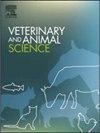了解澳大利亚养殖咸水鳄(Crocodylus porosus)皮革的结构和缺陷
IF 1.9
Q2 AGRICULTURE, DAIRY & ANIMAL SCIENCE
引用次数: 0
摘要
养殖澳大利亚咸水鳄(Crocodylus porosus)是为了收获它们的腹部皮肤,以生产高质量的皮革制品。这是第一个描述性的研究,探讨皮革的结构跨越不同的饰面;在外壳,哑光和光泽以及病变内的变化。利用扫描电子显微镜(SEM)和图像分析,分析了腹部皮肤皮革的厚度和粗糙表面的差异。本研究确定了皮革类型、刻度排向下和中线侧(p = 0.011)以及皮革类型和刻度排向下(p = 0.043)之间的统计学差异。它还确定了与正常皮革相比,线性和局灶性病变中胶原蛋白排列的差异,以及不同深度皮革的影响。本研究注意到皮革结构变化的灶性病变表明病原体,如西尼罗病毒昆津株。本文章由计算机程序翻译,如有差异,请以英文原文为准。
Understanding the structure and blemishes of Australian farmed saltwater crocodile (Crocodylus porosus) leather
Australian saltwater crocodiles (Crocodylus porosus) are farmed to harvest their belly skin to produce high quality leather products. This is the first descriptive study to explore the structure of leather across different finishes; incrust, matte and gloss as well as variation within lesions. Using scanning electron microscopy (SEM) and image analysis, the thickness across the belly skin leather and the differences in the gross surface were analysed. This study identified statistically significant differences between leather type, scale row down and side of the midline (p = 0.011), and leather type and the scale row down (p = 0.043). It also identified the differences in collagen arrangement in linear and foci lesions when compared to normal leather, and the impact at different depths of leather. This study noted a foci lesion with variation in the leather structure indicative of a pathogenic agent such as Kunjin strain of West Nile virus.
求助全文
通过发布文献求助,成功后即可免费获取论文全文。
去求助
来源期刊

Veterinary and Animal Science
Veterinary-Veterinary (all)
CiteScore
3.50
自引率
0.00%
发文量
43
审稿时长
47 days
 求助内容:
求助内容: 应助结果提醒方式:
应助结果提醒方式:


